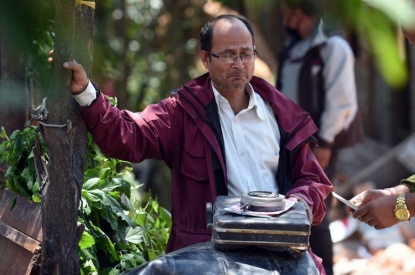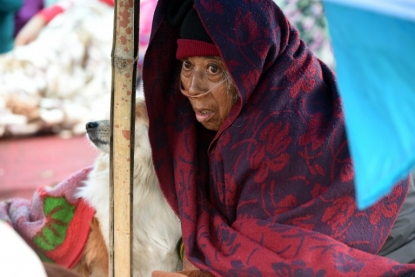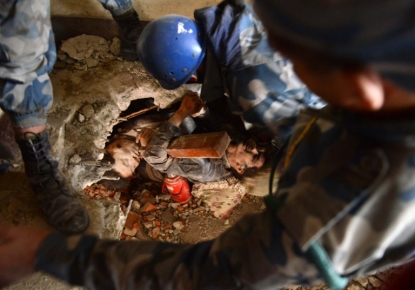Dignity and duty in ruined Kathmandu
KATHMANDU, April 29, 2015 – We have been outside the collapsed house in Kathmandu’s Balaju district for two hours now. The family who live here fled when the earthquake struck two days earlier but two of its members are still missing. Fourteen-year-old Prasamsah and her 38-year-old aunt. Their relatives hover anxiously nearby as search teams scour the rubble for survivors.
Here before our eyes, these people’s whole lives are being pulled from their home piece by piece in the hands of the rescuers. Portraits of their ancestors, a clothes iron, an old VCR player, a photo of Prasamsah which her father dusts off and hugs close to his body.
I am here with two colleagues, the text reporter Bhuvan Bagga and photographer Prakash Singh, and we find ourselves empathising strongly with this family. Like them, we want to believe all will end well, that Prasamsah and her aunt will soon be pulled safe from the debris of their home.
Video: rescuers search for survivors in a Kathmandu home
When a rescuer finally breaks the awful news that they have found the teen’s lifeless body, we feel crushed. And suddenly we no longer dare look in the eyes of these people whose anguish and hope we have been sharing for hours. We no longer dare go near them even, to do our jobs, interview them, film them, photograph them. I tell myself that if my own daughter had just died, I wouldn’t want anyone sticking a camera under my nose to film my tears.
We don’t know what to do. Prakash manages to take a few pictures with a telelens. I force myself to take two or three wide shots, from a distance. Because of course we have to record this.
 Nepali man Gaya Ram, as police retrieve the body of his daughter Prasamsah on April 27, 2015 (AFP Photo / Prakash Singh)
Nepali man Gaya Ram, as police retrieve the body of his daughter Prasamsah on April 27, 2015 (AFP Photo / Prakash Singh)At this point the toll from the April 25 earthquake in Nepal has passed 5,000. Each of these victims was a human being, with their personality, their story, their family. So yes, we need to film, photograph, tell these stories to reach out and touch the public – and make sure the disaster is perceived as more than just a flood of official statements and statistics. But there are times when it is a wrench, just to do your job.
This is the second time I have covered a major natural disaster. The first was in Tacloban, in the Philippines, after Typhoon Haiyan struck in November 2013. The people I met in the Philippines had a very different way of responding to tragedy. First they would try to smile, but more often than not the smile would falter and they would end up in tears before me.

Nepalese patient Sanu Ranjitkar breathes oxygen from a cylinder under a makeshift shelter in Kathmandu on April 27, 2015
(AFP Photo / Prakash Singh)
What strikes me in Nepal is how deeply reserved its people are. They don’t force a smile, but when tragedy strikes they take their faces in their hands, stare at the ground, try any way they can to hide their grief.
Keep feelings private
It is particularly striking in hospitals. Even in rooms packed with the seriously injured, with children in pain, you don’t see anyone break down. One time only, I see a woman howl with despair, until a relative covers up her mouth with his hand.
Filming these people’s pain is a challenge. When someone is crying out, weeping, you get the sense they are calling for help. I feel less awkward training a camera on them – than on someone who is doing all they can to stay dignified and keep their feelings private.
 Nepalis mourn a relative at a mass cremation in Kathmandu on April 26, 2015 (AFP Photo / Prakash Mathema)
Nepalis mourn a relative at a mass cremation in Kathmandu on April 26, 2015 (AFP Photo / Prakash Mathema)In one regard, covering the earthquake in Nepal is less trying than my mission to the Philippines, where the stench of bodies rotting on the streets caught me in the throat the moment I stepped off the plane. Here the bodies pulled from the rubble are rapidly incinerated in line with both Buddhist and Hindu tradition.
Aftershocks jolt the city
But the work here is also much more dangerous, because of the constant, violent aftershocks that keep jolting the area. Shortly after our arrival, on the morning of Sunday April 26, we have barely left a hospital where we are reporting on survivors when a 6.9-magnitude aftershock rocks the city. The tremor sends newly-discharged patients – some of them in wheelchairs – into a panic, with people scattering in all directions. It is a truly frightening experience.

Rescuers help a trapped earthquake survivor as his friend lies dead next to him in Kathmandu on April 26, 2015
(AFP Photo / Prakash Mathema)
Come that evening, AFP’s whole team decides to pack into our one-storey Kathmandu office rather than use the rooms we had booked on the upper floors of a large hotel. Safety comes before comfort, and in any event we are infinitely better off than all those who have lost their homes or are too afraid to return, and are camping out in the cold. Thinking of their ordeal, which is likely to last for weeks on end, makes any discomfort of our own pale by comparison. That night there are two or three big aftershocks, sending objects rocking around and putting out the lights. Half asleep by that point, it feels like a bad dream.
Buildings on verge of collapse
On Tuesday morning, our photographer Prakash Singh and I set off to take some high-up shots of the area around Kathmandu’s Durbar Square, to show the full scale of destruction to the historic site.
We make our way into a building aiming to climb up to the top but a resident tries to talk us out of it. Too dangerous: it would only take one aftershock for the whole place to come crumbling down for good. In the end we do climb, gingerly, to the top, but the deep cracks running along the walls are not reassuring. We stay only as long as it takes to get our shots.
Video: Searching for survivors in Kathmandu
The other challenge we face here, is the sheer number of journalists. How do you tell a story when there are hundreds of people all trying to do the same thing? Thankfully for us, AFP’s network makes a big difference on the ground. We are very fortunate to have an operation already in place here, and Nepalese journalists who know their country well, like our text reporter Paavan Mathema and her cousin the photographer Prakash Mathema.
Another way to try to do original work is to let yourself be carried by events. Not tie yourself down with rigid plans like trying at all costs to film a hospital scene, a rubble scene, a rescue scene etc. Instead go out on the street, talk to people, run with what you find.
 Nepalese man Suresh Parihar plays with his 8-month-old daughter Sandhaya as he is treated at a hospital in Kathmandu on April 26, 2015 (AFP Photo / Prakash Singh)
Nepalese man Suresh Parihar plays with his 8-month-old daughter Sandhaya as he is treated at a hospital in Kathmandu on April 26, 2015 (AFP Photo / Prakash Singh)Last October I was in Nepal on vacation. I admired the centuries-old monuments that made Kathmandu so enchanting. Most of them have been pulverised. History swept away by nature. It is deeply strange to walk through the ruins of this city, which I saw in all its glory just months ago. It is also very sad. Of course the destruction of Nepali heritage takes second place compared to the human tragedies unfolding all around us. But that heritage is also one of the country’s most precious assets, reduced to rubble, and that loss is bound to leave a lasting mark.
Agnes Bun is an AFP video journalist based in New Delhi and part of a multimedia team sent to Nepal following the earthquake. You can also read the story of AFP journalists Roberto Schmidt and Ammu Kannampilly who survived the deadly avalanche triggered by the earthquake at base camp on Mount Everest.
Video: Nepal's heritage damaged in quake


